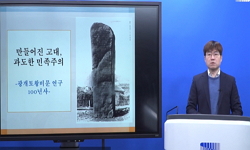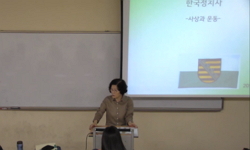This paper traces the history of Manchu Studies as an academic discipline in Japan and China respectively, addressing that the development of Manchu Studies in East Asia shared a common background in strong nationalism. The field of Manchu Studies in ...
http://chineseinput.net/에서 pinyin(병음)방식으로 중국어를 변환할 수 있습니다.
변환된 중국어를 복사하여 사용하시면 됩니다.
- 中文 을 입력하시려면 zhongwen을 입력하시고 space를누르시면됩니다.
- 北京 을 입력하시려면 beijing을 입력하시고 space를 누르시면 됩니다.
https://www.riss.kr/link?id=A104055619
-
저자
김선민 (고려대학교)
- 발행기관
- 학술지명
- 권호사항
-
발행연도
2012
-
작성언어
Korean
-
주제어
일본 만선사 ; 중국 만학 ; 민족주의 ; 변경사적 관점 ; 훈춘 ; Japanese Mansenshi ; Chinese Manxue ; nationalism ; Hunchun ; border perspectives
-
등재정보
KCI등재
-
자료형태
학술저널
-
수록면
89-126(38쪽)
-
KCI 피인용횟수
9
- DOI식별코드
- 제공처
- 소장기관
-
0
상세조회 -
0
다운로드
부가정보
다국어 초록 (Multilingual Abstract)
By this time, the Chinese were also struggling with their mission of searching for modern China. But they faced more arduous task than their Japanese counterparts, because they had to destroy the Qing Manchus, but simultaneously succeeding the Qing legacy, most notably, its vast territory. This paper explores the history of Manchu Studies in China in the context of nationalism, which required separating China from the Qing and the Manchus in the late nineteenth century, while now encouraging the contemporary Chinese scholars to identify the Great Qing empire with the People’s Republic of China in the early twentieth century. By juxtaposing the two different regional terms, “Manchuria-Korea” (Mansen) in Japan and the “Northeast” (Dongbei) in China, we can be sure that both Japan and China have developed their territorial interests in Manchuria and scholarly questions for Manchu Studies from the same ideology, namely nationalism, an idea that newly emerged in East Asia in the early twentieth century.
As a new agenda for Manchu Studies in Korea, this paper suggests a perspective from borders, an alternative critique to nationalism in which Manchu Studies in Japan and China has been embedded for a century long. After a brief review of Korean historiography of the Qing-Choson relations in general and Kim Hangyu’s arguments for “History of Liaodong” (Yodong sa) in particular, it discusses the ways in which a perspective focusing on borders where contacts and conflicts between different groups took place will be able to contribute to expand Manchu Studies.
This paper traces the history of Manchu Studies as an academic discipline in Japan and China respectively, addressing that the development of Manchu Studies in East Asia shared a common background in strong nationalism. The field of Manchu Studies in Japan was arguably developed along with “East Asian History” (Toyoshi), a modern scholarly discipline that emerged under the influence of European thoughts and education system introduced to Japan since the late nineteenth century. This paper explains that Japanese scholars invented such new concepts as “East Asia” (Toyo) and East Asian History (Toyoshi) as part of their efforts in search for modern Japan, and later expanded their scholarly inquiries into Korea and Manchuria and eventually established the so-called “History of Manchuria and Korea” (Mansenshi), which contributed to justify the Japanese imperialist policy in Korea, Manchuria and China.
By this time, the Chinese were also struggling with their mission of searching for modern China. But they faced more arduous task than their Japanese counterparts, because they had to destroy the Qing Manchus, but simultaneously succeeding the Qing legacy, most notably, its vast territory. This paper explores the history of Manchu Studies in China in the context of nationalism, which required separating China from the Qing and the Manchus in the late nineteenth century, while now encouraging the contemporary Chinese scholars to identify the Great Qing empire with the People’s Republic of China in the early twentieth century. By juxtaposing the two different regional terms, “Manchuria-Korea” (Mansen) in Japan and the “Northeast” (Dongbei) in China, we can be sure that both Japan and China have developed their territorial interests in Manchuria and scholarly questions for Manchu Studies from the same ideology, namely nationalism, an idea that newly emerged in East Asia in the early twentieth century.
As a new agenda for Manchu Studies in Korea, this paper suggests a perspective from borders, an alternative critique to nationalism in which Manchu Studies in Japan and China has been embedded for a century long. After a brief review of Korean historiography of the Qing-Choson relations in general and Kim Hangyu’s arguments for “History of Liaodong” (Yodong sa) in particular, it discusses the ways in which a perspective focusing on borders where contacts and conflicts between different groups took place will be able to contribute to expand Manchu Studies.
참고문헌 (Reference)
1 윤대석, "키메라 - 만주국의 초상" 소명 2009
2 마크 엘리엇, "중심으로서의 주변: 만주학의 미래를 위한 서언"
3 유장근, "중국의 청사공정 연구" 동북아역사재단 2008
4 김형종, "중국의 청사 편찬과 청사 연구" 동북아역사재단 2010
5 유장근, "중국 역사학계의 청사연구 동향" 동북아역사재단 2009
6 사카모토 히로코, "중국 민족주의의 신화: 인종․신체․젠더로 본 중국의 근대" 지식의 풍경 2004
7 오병수, "중국 국민사학의 인종․강역문제-梁啓超․章炳麟의 만주 인식을 중심으로-" (14) : 2006
8 프래신짓트 두아라, "주권과 순수성" 나남 327-331, 2006
9 스테판 다나카, "일본 동양학의 구조" 문학과 지성사 2004
10 프라센짓 두아라, "민족의 지구적, 지역적 구성: 동아시아로부터의 관점 In 화이부동의 동아시아학- 민족사와 고대 중국 연구 자료 성찰" 푸른역사 2012
1 윤대석, "키메라 - 만주국의 초상" 소명 2009
2 마크 엘리엇, "중심으로서의 주변: 만주학의 미래를 위한 서언"
3 유장근, "중국의 청사공정 연구" 동북아역사재단 2008
4 김형종, "중국의 청사 편찬과 청사 연구" 동북아역사재단 2010
5 유장근, "중국 역사학계의 청사연구 동향" 동북아역사재단 2009
6 사카모토 히로코, "중국 민족주의의 신화: 인종․신체․젠더로 본 중국의 근대" 지식의 풍경 2004
7 오병수, "중국 국민사학의 인종․강역문제-梁啓超․章炳麟의 만주 인식을 중심으로-" (14) : 2006
8 프래신짓트 두아라, "주권과 순수성" 나남 327-331, 2006
9 스테판 다나카, "일본 동양학의 구조" 문학과 지성사 2004
10 프라센짓 두아라, "민족의 지구적, 지역적 구성: 동아시아로부터의 관점 In 화이부동의 동아시아학- 민족사와 고대 중국 연구 자료 성찰" 푸른역사 2012
11 김한규, "문학과지성사" 요동사 2004
12 고바야시 히데오, "만철: 일본제국의 싱크탱크" 산처럼 2004
13 "만주학 연구의 현황과 과제" 2011
14 홍성구, "만주 역사를 바라보는 한국적 시각의 한 모색 - 許穆과 丁若鏞의 만주 諸種族 인식을 端緖로 -" 호서사학회 (55) : 175-213, 2010
15 요시자와 세이치로, "내셔널리즘으로 본 근대 중국: 애국주의의 형성" 논형 2006
16 中國邊疆史地硏究中心, "琿春副都統衙門檔 전 238冊" 廣西師範大學出版社 2007
17 寺內威太郞, "滿鮮史」硏究と稻葉岩吉 In 植民地主義と歷史學-そのまなさしか殘したもの" 刀水書房 2004
18 王鍾翰, "淸史滿族史硏究百年回顧及未來展望 In 滿學論叢 第1輯" 遼寧民族出版社 2011
19 나카미 타쯔오(中見立夫), "日本的「東洋學」の形成と構圖 In 「帝國」日本の學知, 제3권, 東洋學の磁場" 岩波書店 2006
20 나카미 다쯔오(中見立夫), "日本の東洋史學黎明期のおける史料への探求 In 神田信夫先生古稀記念論集: 淸朝と東アジア" 山川出版社 1992
21 스기야마 키오히코(杉山淸彦), "大淸帝國史硏究の現在-日本における槪況と展望" 10 : 2008
22 나카미 다츠오(中見立夫), "地域槪念의 政治性" 9 : 2009
23 키청거(承志), "中國における「滿族史」硏究" (10) : 2008
24 성근제, "‘東北’인가, ‘滿洲’인가 ― 근대 동북 지역연구과제 설정의 가능성" 한국중국현대문학학회 (56) : 123-146, 2011
25 Joshua A. Fogel, "The Teleology of the Modern Nation-State: Japan and China" University of Pennsylvania Press 2005
동일학술지(권/호) 다른 논문
-
명 중기 복건 신현의 종족문화 확산과 종족형성 ― 縣志의 서술을 중심으로 ―
- 명청사학회
- 원정식
- 2012
- KCI등재
-
明淸과 朝鮮, 朝鮮과 明淸 關係史 연구현황과 과제 ― 수교20주년에 즈음하여 ―
- 명청사학회
- 최소자
- 2012
- KCI등재
-
그 이름 불러주기 ― 실록의 조선ㆍ청나라 호칭(互稱) 분석
- 명청사학회
- 이영옥
- 2012
- KCI등재
-
朝․淸의 學術交流와 通學的 學術觀 ― 19世紀 前半 揚州學派와 秋史 金正喜 ―
- 명청사학회
- 이원석
- 2012
- KCI등재
분석정보
인용정보 인용지수 설명보기
학술지 이력
| 연월일 | 이력구분 | 이력상세 | 등재구분 |
|---|---|---|---|
| 2027 | 평가예정 | 재인증평가 신청대상 (재인증) | |
| 2021-01-01 | 평가 | 등재학술지 유지 (재인증) |  |
| 2018-01-01 | 평가 | 등재학술지 유지 (등재유지) |  |
| 2015-01-01 | 평가 | 등재학술지 유지 (등재유지) |  |
| 2011-01-01 | 평가 | 등재학술지 유지 (등재유지) |  |
| 2009-01-01 | 평가 | 등재학술지 유지 (등재유지) |  |
| 2007-01-01 | 평가 | 등재학술지 유지 (등재유지) |  |
| 2004-01-01 | 평가 | 등재학술지 선정 (등재후보2차) |  |
| 2003-01-01 | 평가 | 등재후보 1차 PASS (등재후보1차) |  |
| 2001-07-01 | 평가 | 등재후보학술지 선정 (신규평가) |  |
학술지 인용정보
| 기준연도 | WOS-KCI 통합IF(2년) | KCIF(2년) | KCIF(3년) |
|---|---|---|---|
| 2016 | 1.76 | 1.76 | 1.35 |
| KCIF(4년) | KCIF(5년) | 중심성지수(3년) | 즉시성지수 |
| 1.17 | 0.99 | 1.779 | 0.14 |




 KCI
KCI KISS
KISS







